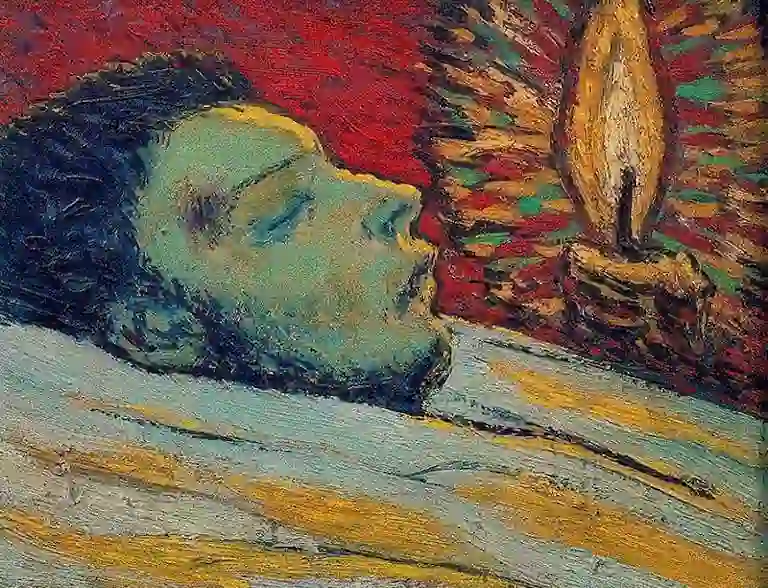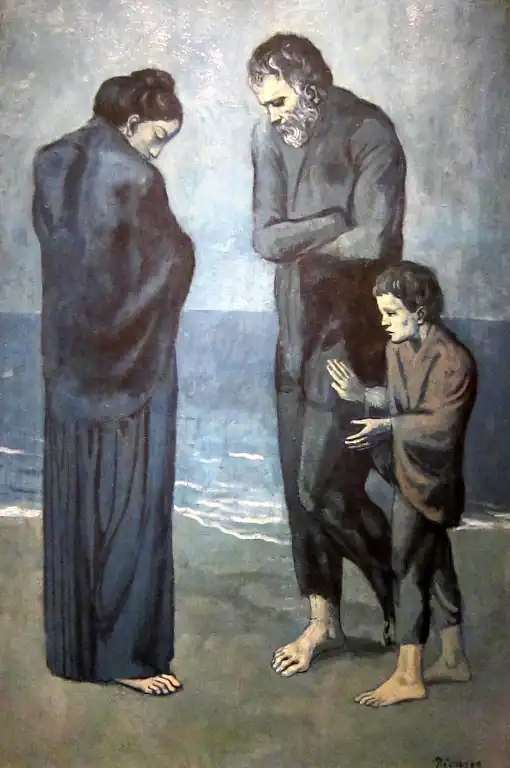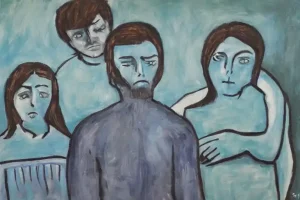The Spanish painter Pablo Picasso is arguably the most significant artist of the 20th century. In 1903, he made the masterpiece “The Tragedy,” which shows a man, a woman, and a child huddled together on the beach. So, what motivated Picasso to paint The Tragedy? And what symbols and themes lie behind this painting?
Picasso painted The Tragedy because he was hurt financially and emotionally by the death of a friend. It was painted during Picasso’s “Blue Period” when he only painted in shades of blue and green. Paintings from this era are frequently solemn and depressing.
The Tragedy is one of Picasso’s “Blue Paintings.” Read on to discover more details about the piece, as well as the symbols and themes used in it.
Background of The Tragedy
Table of Contents
From 1901 to 1904, Picasso had a “Blue Period” where he only painted solemn images of humans. After his trip to Paris and the death of his friend, Picasso’s artistic orientation drastically changed in 1901. [1]
The Blue Period began when Picasso’s friend, Carlos Casegamas, committed suicide. Unrequited love led Casagemas to attempt the murder of his beloved before taking his own life at the L’Hippodrome Café in Paris, France. He shot himself in the right temple on February 17, 1901.
The Tragedy is reworked from one of Picasso’s bull paintings. An X-Ray of the painting revealed an image of an extended, tormented horse. The original painting showed a bullfighting ring and a horse, which is typical of Picasso’s bullfighting works from 1901. In The Tragedy, the original subject was given a new look, which gave Picasso new ideas. [2]
Discover the secrets behind Picasso’s bull paintings and drawings of the animal world. Learn how Bulls and the symbolism of bull fighting reflect the artist’s lifelong fascination with these noble creatures

X-Rays also show the painting hung for four years in Picasso’s studio before “The Tragedy” was painted on top of it. After a studio examined the painting, they saw haphazardly drawn doodles, caricatures, and letters that were made directly on the wood framework. These were part of Picasso’s 1899 sketchbooks.
The original painting was created before the Blue Period when Picasso still used other colors. So, the Tragedy has orange and yellow tones that have no bearing on the dark blue hue of the finished piece. Some of the bright blue paint from the picture below can be seen through the dark blue paint.
The Tragedy became one of the most iconic and recognizable paintings of the Blue Period. Learn all about how the Blue Period encapsulates the themes and emotions of this time in Picasso’s life.
What are the Symbols and Themes Used in The Tragedy?
“The Tragedy” symbolizes Picasso’s devastation after losing his friend Carlos Casagemas. They were in the same circle of friends, and they were even roommates. Later, Picasso even began dating Germaine, Casagemas’ unrequited love. Picasso could not avoid the memories of his deceased friend. This had a significant impact on his artwork in the ensuing weeks and months.
This grief and despair would have a lasting effect on Picasso’s artistic vision and style. Uncover the secrets of Picasso’s signature style, and learn how his use of color, line, and form evolved over the course of his career.
The Tragedy shows a sad image of a family that is struggling, as seen by their clothes. They are barefoot and wearing rags on the beach. The painting might be showing how hard life was at the beginning of the 20th century when poverty and hard times were common. Picasso shows how sad and hopeless the family’s situation is, giving the viewer a sense of desperation and hopelessness.
The family of three looks depressed. They are not making eye contact or showing affection to one another. The man and woman are facing each other. But their expressions show that they are unable to console one another.

The child is reaching out to his mother for help. Perhaps a member of the child’s family, or even a sibling, is being mourned by this family. [3] Art analysts may also think that the child is clueless and doesn’t know about the terrible thing that happened to his family.
The setting of The Tragedy is on the beach, which can be considered a transition between land and sea. The painting demonstrates that tragic events can act as a transition to change people’s lives. The setting might represent how times also change in our daily lives, one moment happy, the next, tragic.
This same theme is explored in Picasso’s painting Cat Catching a Bird. Explore the range of symbolism and meaning in Picasso’s many paintings of birds.
It’s hard to tell if the subjects are in mourning or directly experiencing the tragedy. Even though there are no signs of the tragedy or any particular disaster, some people have inferred that the family is a refugee who had to leave their home because of a disaster. Picasso invites the audience to speculate on the possible sequence of events.
Somber blue and dark green colors depict sadness and despair. If you look at the vast and fascinating career of Picasso, only the Blue Period Paintings possess such tremendously dark emotional depth.
The Blue Period is not the only time where Picasso’s art explored the loss of friends. Discover the emotional depth and significance behind Picasso’s Three Musicians paintings, and how they pay tribute to the artist’s beloved friends who passed away.
Where is the Tragedy Located?
Currently, the East Building in the National Gallery of Art in Washington, D.C. houses Pablo Picasso’s painting “The Tragedy.” It is part of the Chester Dale collection. [4]

Here are some other interesting facts about the Chester Dale Collection:
- Chester Dale collected and gathered many works of art and donated them to a museum.
- Chester Dale is an American banker and art collector. He made a lot of money working for the New York Stock Exchange, which allowed him to buy French artworks primarily from the 19th and 20th centuries.
- Chester Dale donated seven American paintings in 1941 for the gallery’s opening and the rest of his collection at his death. They became known as “From Impressionism To Modernism: The Chester Dale Collection”. [5]
The Louvre is the famous museum in Paris much like the National Gallery of Art. Find out how Picasso once caused a sensation when he was arrested for stealing the Mona Lisa from the Louvre.
Frequently Asked Questions (FAQs)
The Tragedy is a post-impressionist painting. It features the artist’s feelings as seen in the entire Blue Period of Pablo Picasso. Picasso’s depression over the loss of his friend can be felt in his paintings. The Tragedy used monochromatic blue colors. It perfectly conveys the depleted, caved-in sensation of intense loss.
The Tragedy is an oil painting done on wood. It primarily uses blue tones and hues, which is a trademark of pieces done in Picasso’s Blue Period. The canvas measures 105x69cm.
References
- Prouty, Sandy. “Art Reflection – Picasso – The Tragedy.” Montview Boulevard Presbyterian Church, 20 July 2020, https://www.montview.org/art-reflection-picasso-the-tragedy/.
- “Pablo Picasso’s The Tragedy: Metamorphosis of a Painting.” Pablo Picasso’s The Tragedy, https://www.nga.gov/features/slideshows/pablo-picasso-the-tragedy.html.
- Co, Art History. “The Tragedy: Pablo Picasso (1903).” Art History Co, 25 Oct. 2022, https://arthistory.co/the-tragedy-pablo-picasso/.
- Chester Dale, https://web.archive.org/web/20090304155311/http://www.nga.gov/collection/gallery/ggfound/ggfound-30743.html.
- Houghton, Noah. “Chester Dale.” Dumbarton Oaks, 22 Dec. 2017, https://www.doaks.org/resources/cultural-philanthropy/chester-dale
